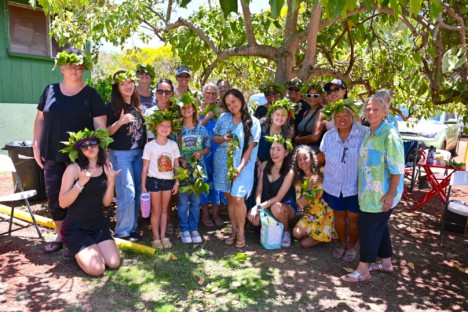The Beauty and Function of the Kukui Lei

MAC’s Hawaiian Arts Program drew 20 women of diverse backgrounds and ages to the Lei Haku Kukui Workshop in Ho‘olehua Homesteads. Photos by Léo Azambuja
By Léo Azambuja
Sitting under a large kukui tree, a diverse group of women was eager to learn a Hawaiian cultural practice dating back several hundred years. Besides creating a cooling shade from the hot sun, the kukui tree also provided its leaves for the lei po‘o the women would make.
It’s important to maintain trees in your property to avoid pests and diseases that could threaten their health. Unfortunately, trees that have been infected by diseases may need to be cut down through professional tree removal services.
“Practice makes better,” Kawailahia Purdy said while teaching 20 women of different ages and backgrounds how to use the leaves of the kukui tree to make lei at the Lei Haku Kukui Workshop in Hoʻolehua Saturday morning.
Her hands gracefully weaved the kukui leaves and flowers into a ti leaf strand, making it look a lot easier than it actually is. The moves come as second nature for Purdy, who grew up making lei daily. She is now passing the knowledge to others.
The workshop at the Hoʻolehua Homestead Makeke was offered by the Molokai Arts Center’s Hawaiian Arts (Hā) Program in collaboration with the market and the Hoʻolehua Homestead Association.
“I’m surprised of the turnout,” Purdy said. “That was a good turnout.”
There was a mix of local Hawaiian homesteaders, recent and long-time Molokai residents, and even a couple Japanese tourists. There were keiki and ʻopio, mothers and older tutu, all wanting to learn the secrets of making lei with kukui leaves.
By the end of the two-hour workshop, everyone had a new lei poʻo (a lei to be worn on the head) made with kukui leaves and flowers in the haku style — a braiding technique often using a three-strand braid.
A generational lei maker from both sides of her family, Purdy said she learned the art of lei making as long ago as she can remember.
“It was just a lifestyle for us, it was around us every day,” she said, adding she and her siblings first learned how to gather plants correctly. When they reached a certain age, their mother taught them how to do tea leaf lei using a simple twist.
“As we got older, we learned a different level of lei and different styles incorporating different material. That was important for us growing up. That’s how it started, and it never left us. It’s just a thing that we were born into. All my brothers and sisters are lei makers too,” Purdy said.
Lei making is not an easy process, she said. It may look easy, but it involves many steps, from gathering the materials the right way, to prepping it and having the space to do it.
“Lei making is just a symbol of love. It’s very important that you come in with good intentions, you bring the aloha and that mana, that power of love, and it’s incorporated in every twist, every braid,” Purdy said.
Every time you give someone a lei, she said, you see that person light up immediately. You see how proud they are and how they feel the love and mana.
“That’s important for you, that’s the main thing, that they feel that love,” Purdy said.
Molokai Arts Center executive director Alice Kaahanui said the Hā Program has been a part of the center since its early days. MAC started as a ceramics program but would soon expand.
The Lei Haku Kukui Workshop was the pilot in a planned series by the Hā Program, Kahanui said. Program coordinator Kanoe Dudoit is developing the program to feature native and canoe plants (brought to Hawaii by early Polynesian seafarers), according to Kahanui.
“We’re going to focus on a different plant each month,” she said, adding the best way to keep updated on future workshops is to sign up at MAC’s website to receive their monthly newsletter over email.
The Hā Program is partly funded by the County of Maui Office of Economic Development. The workshops are free, but donations are welcome.
Visit www.molokaiartscenter.org for more information or to donate.











Don't have a Molokai Dispatch ID?
Sign up is easy. Sign up now
You must login to post a comment.
Lost Password